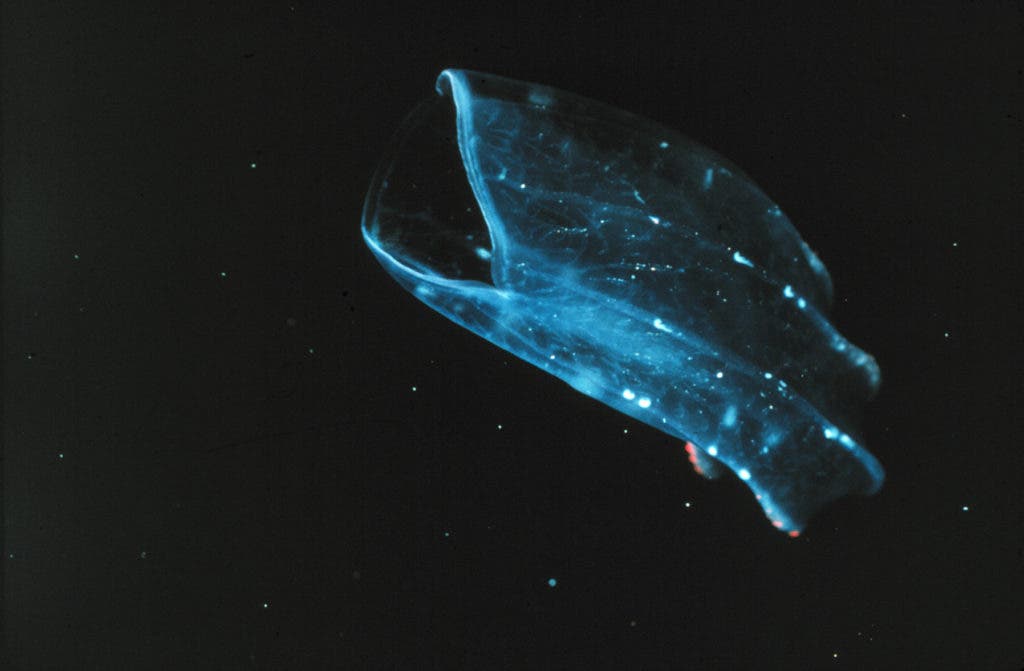Since 2008, scientists have debated which of the two came first: the sponge (Porifera) or the comb jelly (Ctenophora). A new thorough genetic analysis suggests the latter was Earth’s first animal out of which all other creatures evolved.
Editor’s note: while very similar, comb jellies technically aren’t jellyfish (subphylum Ctenophora vs phylum Medusozoa). The term ‘jellyfish‘ in this article refers to comb jellies. Thanks to Wastrel Way for pointing it out.

For more than a century, biologists generally agreed that the first creature to evolve on this planet was a sponge because it’s such a simple creature. The sponge doesn’t have circulatory, nervous, or digestive systems, and only needs water to flow through its pores to survive. After DNA was discovered, and much later when modern genetic sequencing tools appeared, the status of the sponge as the first animal in the world seemed even more cemented. One previous genetic analysis, for instance, showed most genes involved in complex processes are present in sponges.
The sponge, however, isn’t the only ancient animal at the bottom of all modern creature’s lineage. In 2008, a family-tree study pointed out that the comb jellies came before the sponge, and ever since scientists have been locked in a debate. A recent study which attempted to resolve the early diversification of animal lineages used a massive 1,719-gene dataset with dense taxonomic sampling and found evidence supporting the idea that sponges represent the sister group to all other animals.
While impressive, Antonis Rokas, a biology professor at Vanderbilt University, cautions that such ‘big data’ analyses can still pose phylogenomic contradictions.
“This has worked extremely well in 95 percent of the cases, but it has led to apparently irreconcilable differences in the remaining 5 percent,” Rokas said in a statement.
In a new paper published in Nature Ecology & Evolution, Rokas and colleagues employed a new approach to settle 18 controversial phylogenetic relationships, among them the ‘sponge vs comb jellyfish’ debate. In total, the study included seven relationships from animals, five from plants, and six from fungi in order to figure out why so many studies have come up with such conflicting results. To get to the bottom of things, the researchers painstakingly compared the individual genes of the leading contenders in each relationship. That’s hundreds of thousands of genes.
“In these analyses, we only use genes that are shared across all organisms,” Rokas said. “The trick is to examine the gene sequences from different organisms to figure out who they identify as their closest relatives. When you look at a particular gene in an organism—let’s call it A—we ask if it is most closely related to its counterpart in organism B? Or to its counterpart in organism C? And by how much?”
By determining which genes weighed more for a particular hypothesis, like ‘comb jelly came first’, and by labeling the resulting differences as a ‘phylogenetic signal’, the team determined that the comb jelly has significantly more genes which support its ‘first to diverge’ status than the sponge.
Besides jellyfish vs sponges, the researchers also addressed other phylogenetic conflicts like whether crocodiles are more related to birds or turtles. Using the same method, the researchers found 74 percent of the shared genes indicate that crocodiles and birds form sister lineages while turtles are just close cousins.
As to why previous efforts turned out to be so controversial, Rokas suggests the statistical methods used by evolutionary biologists are influenced by ‘strongly opinionated genes’. Only a handful of such genes, which have a strong phylogenetic signal for one of the specific hypotheses, pop up in studies, but these are enough to skew results. For instance, in the case of another controversy surrounding flowering plants and modern birds, the researchers found that removing a single opinionated gene flipped the results from one candidate to another. In this particular case, the team published an inconclusive result either because the available data is inadequate or because the diversification occurred too rapidly to resolve.
“We believe that our approach can help resolve many of these long-standing controversies and raise the game of phylogenetic reconstruction to a new level,” Rokas said.
Of course, that’s not to say this is the final word on the matter. As outlined earlier, it was only in March that a comprehensive genetic analysis gave credence to sponges as the ‘first to diverge’ in favor of the jellyfish. It’s likely that the two will switch roles multiple times before biologists reach a satisfying method. It’s amazing, however, that out of the millions of species that lived on Earth we’re able to single out only two main candidates. That, in itself, is a testimony to how powerful science is.



